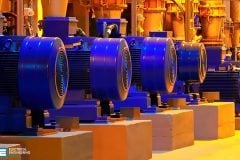A building site and electrical equipment
A building site is to have the following electrical equipment available for use:
- Tower crane, electric motors totalling 75 kW at 415 V;
- Sump pump, 5 kW at 240 V;
- 60 tungsten lamps of 100 W each at 240 V;
- 12 flood lamps of 400 W each at 240 V;
- 20 hand tools of 400 W at 110 V.

To calculate //
- Find the total kilovolt-amperes to be supplied to the site if the power factor of all rotary equipment is 0.8.
- Find the electrical current rating for the incoming supply cable to the site.
- Estimate the cost of electricity consumed on the site during a 12-month contract.
Ok, let’s do it…
For rotating machinery, formulae for power in Volt Amperes [VA] goes like this:
![]()
For single-phase current:

For three-phase current:

The results of the power calculations are given in Table 1 below. The answers required are as follows.
1. The total input power kilovolt-amperes required for site is 120.8 kVA
2. The incoming supply cable capacity at 415 volt, three-phase, 50 Hz required is:

3. Assume that the crane, pump and tools are running for 25% of an 8-h working day, 5 days per week for 48 weeks, 20 of the tungsten lamps are for security lighting 16 h every night, and the remaining 40 tungsten lamps and the flood lamps are used for 3 h per day, 5 days per week for the winter period of 20 weeks.
The crane, pump and tools are working for:

The security lamps are working for:
![]()
The other lamps are working for:

Table 1 – Building site plant schedule
| Equipment | Power (kW) | Number | kW | kVA | V | A |
| Tower Crane | 75 | 1 | 75 | 93.75 | 415 | 130.4 |
| Sump Pump | 5 | 1 | 5 | 6.25 | 240 | 26 |
| Lamps | 0.1 | 60 | 6 | 6 | 240 | 25 |
| Flood Lamps | 0.4 | 12 | 4.8 | 4.8 | 240 | 20 |
| Hand Tools | 0.4 | 20 | 8 | 10 | 110 | 90.9 |
| Total // | 98.8 | 120.8 | n.a. | n.a. |
Table 2 – Building site energy use
| Equipment | Power (kW) | Number | Time (h) | Energy (kWh) |
| Tower Crane | 75 | 1 | 480 | 36000 |
| Sump Pump | 5 | 1 | 480 | 2400 |
| Tungsten lamps, security Lamps | 0.1 | 20 | 5824 | 11648 |
| Lamps | 0.1 | 40 | 300 | 1200 |
| Flood Lamps | 0.4 | 12 | 300 | 1440 |
| Hand Tools | 0.4 | 20 | 480 | 3840 |
| Total Power Used // | 56528 |
The total energy used by the systems is found from:
kWh = number of appliances × kW per appliance × operation hours as shown in Table 2.
If electricity costs 8 p per unit (kWh) then the estimated cost for the 1-year contract will be:

Reference: Building Services Engineering // Electrical Installations – David V. Chadderton (Purchase paperback from Amazon)











I need to know how to calculate MD
Thanks alot.. I’m most grateful
Thank You so much, its really helpful.
How to calculate MD in electrical language.
I have problem in one of the site where the connecting load is High HP pump -150 and 60 with 500kva transformer connected .
the MD is 185 connected obtained but the ideal time is so high that power factor is getting low checked out the parameters additional 1.5KVAR given for the grid than also the power factor is not getting maintained.
last month MD shooted up to 193.4 KVA but the running of the plant was minimal .
Help out in this regards
hay i am doing analysis on base of MDI penalty can anyone please tell me that how it is calculated. in bill i find readings like this
PRV CUMM MDI 98 PRS CUMM MDI 104 MDI 6
what does this mean….
we just start a construction of abig project at ajyad of mekkah saudi arabia we wanna make calculation of the total power needed for service using demand and load factor please tel me me how to compute the demand factor
Thank you for the information
Thanks for the Information
thanks
I’m so sorry i had forgotten the principle of the power triangle so sorry really the 93.75kva for the crane is correct.
Nice good and very helpful
How about the power consumption for testing& commissioning?
Thanks for your information, but one think..for three phase , power W=1.732xV(line)xI(line)xPF no? if so that means VA =W/(1.732×0.8) and the KVA for the crane would be 54.13KVA….
No. Active power (W) is equal to VA x power factor
Thanks u for ur information
Thanks for the information.
Thank you Edvard Csanyi for an informative and summarized example.
it assisted me in a project I am doing now.
I keep reading your articles, these are very helpful articles
the whole page is very useful, keep up the good work